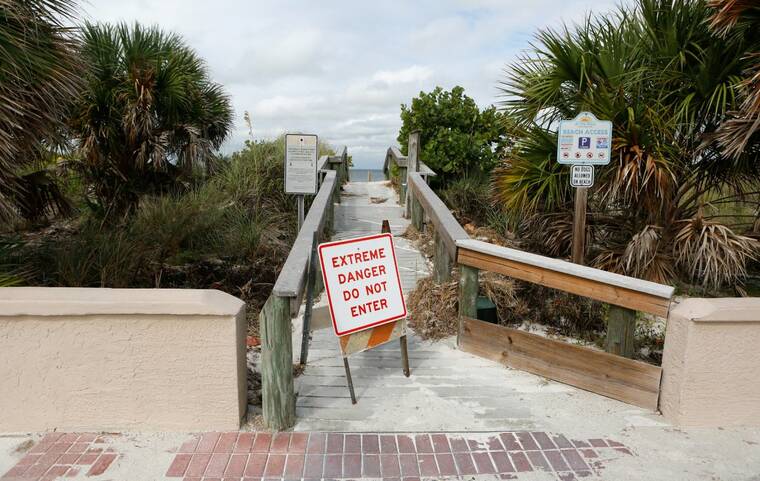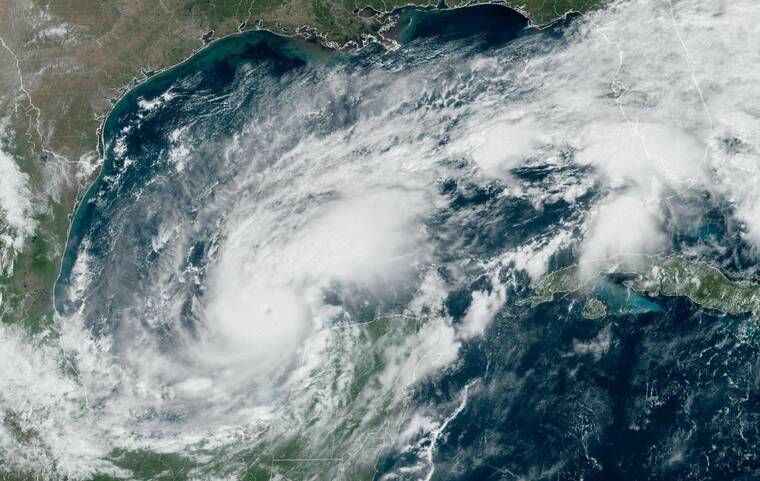Hurricane Milton now a Category 5 storm, taking aim at Florida

REUTERS/OCTAVIO JONES
A sign is seen at the entrance to the beach before the arrival of Hurricane Milton, St. Pete Beach, Fla., today.

CIRA/NOAA/HANDOUT VIA REUTERS
A satellite image shows Hurricane Milton intensifying before its expected landfall in Florida, in the Gulf of Mexico, today.


Hurricane Milton strengthened into a Category 5 storm on Monday, posing an immediate threat to Mexico’s Yucatan Peninsula on its way to Florida, where the state ordered mass evacuations while still recovering from the devastation of Hurricane Helene.
With maximum sustained winds of 180 miles per hour (285 kph), Milton was categorized as the strongest level storm on the five-step Saffir-Simpson scale.
Milton was classified as a tropical storm on Sunday afternoon but in less than 24 hours it “explosively” morphed into a Category 5 storm — the third fastest intensifying storm on record in the Atlantic Ocean, according to the U.S. National Hurricane Center.
Though it was likely to weaken by the time it makes landfall in Florida on Wednesday, counties along the state’s western coast ordered evacuations as they braced for potentially catastrophic winds, rain and a storm surge of eight to 12 feet (2.4 to 3.7 meters).
The hurricane center projected the storm was likely to hit near the Tampa Bay metropolitan area, home to more than 3 million people.
Pinellas County, which includes St. Petersburg, ordered on Monday the mandatory evacuation of more than 500,000 people. Other counties ordered people in low-lying areas to take shelter on higher ground.
Don't miss out on what's happening!
Stay in touch with breaking news, as it happens, conveniently in your email inbox. It's FREE!
With barely 24 hours for people to mobilize, officials raised concerns of traffic jams and long lines at gas stations, but nonetheless urged people to take the storm as deadly serious.
“There’s no other way to put this. Over the next few days, Tampa Bay is faced with the biggest hurricane it’s had for more than 100 years,” Pinellas County emergency management director Cathie Perkins told a press conference.
A Category 3 storm in 1921, before storms were named, devastated the Tampa Bay area. It had a storm surge of 11 feet (3.4 meters).
“We’ve seen the old black-and-white pictures, but we’re about to have the 3-D reality,” Perkins said.
Milton skirted the northern edge of the Yucatan Peninsula, including its tourist hotspots and cargo ports. The hurricane center said the storm surge the could raise water levels by up to six feet (1.8 meters).
The area is home to the picturesque colonial-era city of Merida, population 1.2 million, and close to several Maya ruins popular with tourists and the port of Progreso.
As of 4 p.m. CDT (2100 GMT), the storm was about 80 miles (125 km) west-northwest of Progreso and 675 miles (1,085 km) southwest of Tampa, moving east at 10 mph (17 kph), the hurricane center said.
“Damaging hurricane-force winds and a life-threatening storm surge with destructive waves are expected across portions of the northern coast of the Yucatan Peninsula through tonight,” the hurricane center said. “Milton is expected to grow in size and remain an extremely dangerous hurricane when it approaches the west coast of Florida on Wednesday.”
After making landfall somewhere around the Tampa-St. Petersburg area on Wednesday, Milton was projected to cross the Florida peninsula and still emerge as a hurricane on the Atlantic coast.
“It’s going to be powerful, so please take the appropriate precautions,” said Florida Governor Ron DeSantis during a news briefing after issuing a state-of-emergency declaration for 51 counties. “This has the potential to have a lot of damage.”
President Joe Biden also declared an emergency for Florida, allowing federal disaster-relief operations to commence.
Relief efforts are already underway throughout the U.S. Southeast in the wake of Helene, a Category-4 hurricane that killed more than 200 people across six states. It was the deadliest named storm to hit the U.S. mainland since Hurricane Katrina killed nearly 1,400 people in 2005.
With Milton bearing down on Florida, forecasts of a supercharged Atlantic hurricane season were starting to look more on target than they did at the beginning of September, typically the peak time for the formation of named storms.
Milton is the season’s ninth hurricane, and the second Atlantic storm to reach Category 5 this season after Beryl, which in July became the earliest storm to reach that distinction.



